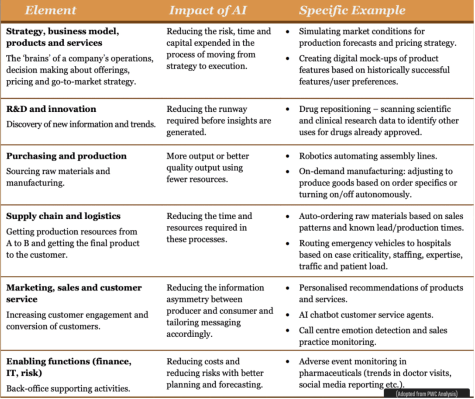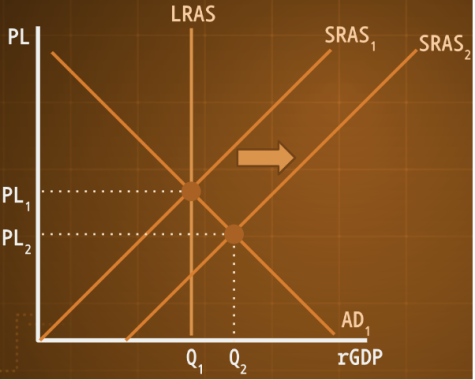The Economic Impact of Artificial Intelligence

June 9, 2023
In the rapidly advancing world that we live in, Artificial Intelligence (AI) is becoming quite prevalent. In its simplest form, AI is a computer system that has the ability to perform tasks that resemble those of humans, including learning, understanding, reasoning, and interacting all while sensing their environment. Examples of AI programs include ChatGPT, Google Bard, Bing AI, Snapchat, AI, Siri, and Tesla Cars, among numerous others. With the advent of this new, disrupting technology, AI has the capacity to change the way we live and work. Thus, it’s important to realize the impact of AI on consumers, businesses, and the economy as a whole.
The first major element of the economy that is affected by AI are businesses. This is because, with the introduction of AI in industries, AI becomes an engine of productivity, and consequently, economic growth. Specifically, AI increases labor productivity—the output of goods and services per hour of labor. For example, by quickly carrying out repetitive and tedious procedures that humans take time to do, humans can instead bring their attention to more complex and growth-oriented tasks that increase labor productivity. In addition, AI can enhance business processes and operations by detecting inefficiencies and areas of improvement in order for a given company to increase output, thereby increasing labor productivity. Already, AI is assisting businesses as it generates personalized TV and music recommendations on streaming services. Perhaps, this can lead to AI assisting in the production of movies by discovering the most optimal characters and storylines to appeal to a given audience. In turn, this heightened appeal to consumers could lead to more output for businesses with fewer hours of labor, leading to a further increase in productivity. The chart below lists many other elements of business, as well as specific examples, of which AI can impact to increase productivity:

Applying this to the fundamental Aggregate Supply-Aggregate Demand macroeconomic model, such increases in productivity increase aggregate supply, leading toward a lower price level (inflation) and an increased real output (rGDP).

The other large component of the economy that is affected by AI is consumers. This is because AI can help increase consumer demand for goods and services. First, AI increases personalization for consumers, as it assists in discovering human preferences while collecting data along a buyer’s journey and using it to enhance their consuming experience. In turn, this leads to a higher level of utility (satisfaction) for consumers, and demand for goods and services increases. AI helps consumers by also reducing the amount of time that they spend doing their daily activities, which means that more time will be devoted to consuming additional goods and services. For example, autonomous vehicles (which use AI to drive) save consumers’ time as they no longer have to drive, and as a result, they can just sit back, relax, and consume other goods and services. AI also saves consumers’ time by making the consumption process easier, helping consumers find their desired products with more efficiency. As a result, consumer demand increases. Lastly, the heightened quality of goods, as mentioned when discussing the impact of AI on businesses, leads to consumers’ marginal utility per unit of consumption (the satisfaction a consumer gains for each unit of output they consume) to also increase. As consumer demand and consumption increase, businesses have increased profits, which motivates firms to enter the market. Consequently, this leads to more competition, which causes prices to fall. When this happens, demand increases even more as goods become more affordable.

With the adoption of AI having the ability to increase both aggregate demand and aggregate supply, it can lead to economic growth. A study by PricewaterhouseCoopers (PwC) predicts that “Global GDP may increase by up to 14% by 2030 as a result of the accelerating development and take-up of AI—adding a potential $15.7 trillion”
However, as promising as AI might sound, there are still drawbacks to it. First, AI can lead to the creation of “superfirms” where epicenters of money and knowledge are accumulated, which can lead to disadvantageous effects on the economy. In addition, AI has the potential to widen the gap between developing and developed countries as developing countries have much fewer resources and access to adopt and utilize AI. Furthermore, since AI boosts the need for workers with particular skills while making other workers obsolete, higher unemployment in the labor market and increased income inequality can transpire. Most unsettling, however, if AI is advancing and developing to help us move faster, where does it go? The limits to what we do are due to the idea that the human mind can only do so much. But with AI, it could continuously develop and create information… to what point? AI can possibly take over all jobs and develop faster than humans can. But then, if humans don’t work, what economy will there be? Many prominent leaders at the forefront of AI development have warned about the dark side of AI. Such people include Elon Musk, Geoffrey Hinton (the “Godfather of AI” at Google), and Gary Marcus. Elon Musk warns: “There will be fewer and fewer jobs that a robot cannot do better. And what are the people gonna do?”
Regardless of whether AI will have a positive impact, a negative impact, or both on our economy, its disrupting technology is one that we must watch out for and learn how to implement effectively. The effects of AI in our world have already been seen and this is just the beginning. As we navigate through this disruptive technology, it is crucial to address the ethical implications, mitigate risks, and ensure effective implementation. Whether we embrace or fear it, AI is undeniably the future that we must prepare for and adapt to.
















































































































































